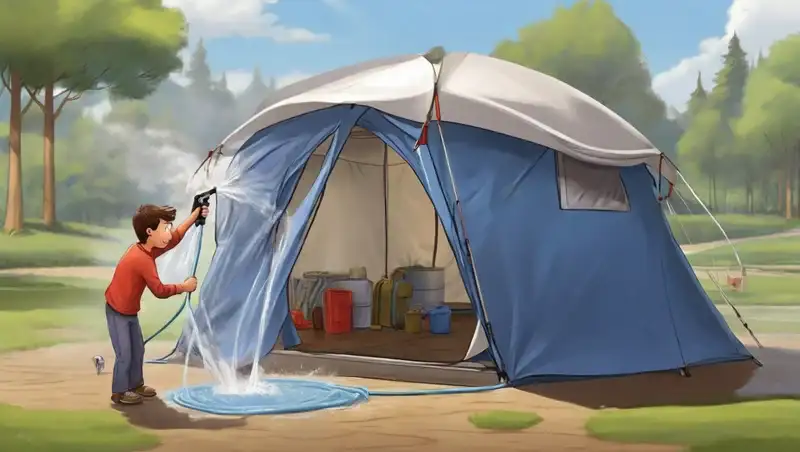I have seen several videos on YouTube where the authors were claiming that the tent they were using was leaking. However, it was obvious that this was just a condensation.
The right way is to test the tent in a controlled environment, and this means in the garden at home. So spray it with water thoroughly and check after that what you have inside, or stay in the tent and watch while somebody sprays the tent. This may save you from unpleasant situations later in the camp and from wrong conclusions as well.

Examples of obviously wrong claims
In one video, the person was surprised with water on the walls inside although she had only some weak rain in the camp during the night. She also mentioned that humidity was at its maximum. But she said the tent was leaking.
Very recently, I commented on a video where the author gave a positive review of a very expensive tent and he was even showing the seams that were nicely sealed and taped. But he claimed that the tent leaked.
He was showing some places with a bit of water at the bottom close to the walls. I asked “Are you sure this was leak and not condensation?”, and soon after that I realized that my comment was deleted.
In numerous comments under the same video, I have noticed many users saying they have never had leaking in that same tent. So I am pretty sure this was just a condensation, but hey, I questioned his authority and he could not stand my comment.
The point is, almost any tent can leak. This can be due to various reasons. I had such an experience at 3000 meters of elevation in the Alps. The tent was from a budget-friendly brand, and untested before going into mountains. I could see water getting inside as soon as the storm started, and this was very soon after I set it up. So I did not have a choice but to abandon my camp and to descend into a hut that was not far.
But very frequently it is not a leak, it is condensation. Now, if you post videos with a claim about leak, and have tens or hundreds of thousands of followers, this can cause serious financial problems to the seller and brand.
So be fair and do not make strong claims unless you are completely sure. Sellers can even sue you, so such claims may turn to be costly.

Understanding condensation
Condensation is an inherent natural occurrence, challenging to evade entirely. Often misconstrued as a tent leak, it can cast a shadow over your camping escapade.
When water accumulates inside your tent, the culprit might be condensation, not a leak. Tents boast impressive waterproofing, but the challenge lies in allowing trapped moisture to escape.
You can have condensation even in an empty tent. But there is far more of it with people sleeping inside because we exhale vapor that condenses on the underside of the tent’s fly.
This is because temperatures drop in the evening and the moisture-laden air meets the cooler tent fabric, resulting in condensation. In other words, condensation forms when moisture in the air turns into tiny droplets of water on the tent’s fabric, like dew on a spiderweb.
Activities like cooking, using heaters, and sleeping intensify condensation within the tent. The key is to promptly open all vents upon pitching the tent, regardless of the weather, facilitating proper ventilation.
My own tents’ condensation experience
I was in the Alps last summer with three different tents. I had my solo Ferrino for the trail, Crua Duo Dome for places closer to the car, and Snow Peak Alpha Breeze when I was in the official camping places. All of them are shown in the text here in the site where I also discuss condensation but specifically in single-layer tents.
So I could see how differently they were performing in different environments. I can tell you, I had condensation in all of them. These are polyester non-breathable fabric tents treated for waterproofing and with a coating. So they inadvertently trap moisture inside the tent and this is something you cannot avoid.
Identifying condensation
Distinguishing between condensation and a leak is essential. In an inflatable tent condensation may manifest as dampness along airbeams, water pooling at beam bases. In all tents, you may have a subtle film of liquid on the tent’s fly underside.
But in general, if you wake up to overnight condensation without any water leakage during rainfall, it’s likely condensation at play.
Sewn-in groundsheets may exacerbate condensation by trapping moisture and warm air. While they offer insulation and protection, they limit airflow, contributing to moisture buildup.
However, even this is issue may be far more complicated. When you have a fly above ground, like in the case of the so-called fast-fly setup, vapor originating naturally from the ground will be prevented from escaping and you will see condensation on the fly’s underside.
Polyester tents vs. polycotton alternatives
Polyester’s susceptibility to condensation prompts consideration of polycotton alternatives for those prioritizing camping comfort.
Polycotton tents breathe naturally, minimizing condensation, but come with added weight and cost considerations. However, even cotton and polycotton tents can have a PU coating, and in this case fabric’s breathability is compromised.
Detecting a truly leaking tent
As I mentioned above, sometimes you can directly see when a storm starts and water leaks inside. I have experienced this in my own tent.
But if the leak is not really visible, pay attention on consistent water pooling in specific areas and pronounced water ingress that signifies a leak.
It is important to stress that, unlike condensation, leaks persistently target specific spots, causing significant dampness in that part of the tent.
But then again, I mentioned air beams where you also can have consistent condensation always in the same areas. Namely, temperature variations inside the beams can trigger evening condensation, often observable at the beam base. Recognizing this as condensation, especially if widespread, is crucial.
What to do if the tent really starts leaking?
This will depend on the current situation and where you are. Last summer, after 11 hours of rain during the night, I have seen people taking out their sleeping bags and pads to dry. My mentioned Snow Peak Alpha Breeze was completely dry.
So, when you are in the camp there is not much you can do, unless you have some repair kit. Leaks are typically at the seams so such repair kits may help providing that you are able to find the place where it leaks.
But in general, make some good photos and when you are able, contact the seller or manufacturer. Then try to find out with them if they can reimburse you or send a new tent.
Do all tents leak in heavy rain?
The answer is short: definitely not. I have quite a few of them and I can rely on them. In most cases, when you see water on the underside, this is condensation.
Final thoughts
In conclusion, leaking and condensation in a tent are very frequently mixed-up and misunderstood. Before hastily labeling your tent as leaky, it is highly advisable to consider condensation. Testing the tent at home with a hose-pipe and, if necessary, seeking a manufacturer’s water test can provide clarity.
This is the only right approach, and this applies in particular to those who make living by reviewing outdoor products. Their numerous followers deserve the correct information and not some unsubstantiated bombastic and irresponsible claims of the type “I do not work for them (sellers & brands), I work for you.”
This may sound great for viewers, but it should be about responsibility regarding both sides. There are serious brands out there, we buy their products because we trust them and we love them. They deserve respect from those who test their products.
Thank you for reading. Please let me know if you have questions, there is a comment box below. Check for more texts of this type in the category FAQs here in the site.
Bookmark this site and keep as a reference, it is all about family camping tents and related questions. Subscribe to my weekly newsletter and stay informed.
Leave a Reply